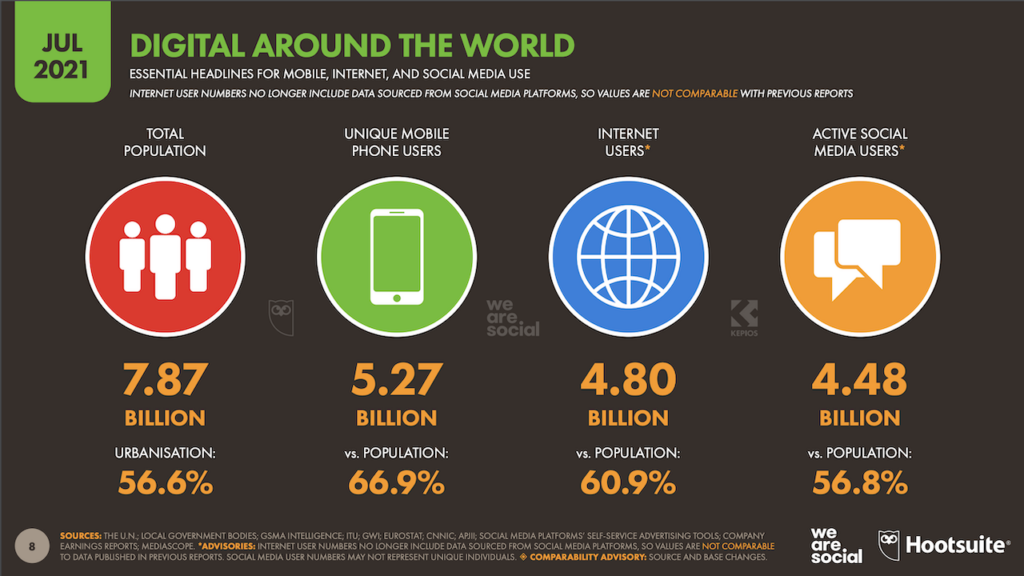According to the latest research by Datareportal, there are approximately 4.5 billion users on social media today. That’s more than fifty percent of the global population, with that number growing by more than 13% in the last year alone. They also report that of that number of social media users, the average time spent on social media per day is almost two and a half hours per user. That’s a significant population and a generous window of opportunity for leaders to engage with existing audiences and share vital messaging.

But stepping out into the social media universe without a message strategy and a plan can be a waste of time and even cause problems if you’re not careful. However, if you’re the CEO or a functional leader, or even if you oversee a small team, it’s essential to figure out how you’ll best use your social media presence. Then you’ll need to build a plan that lets you stay on course, remain active, and always be visible to the right audiences.
Of course, leaders have enough on their plate and barely keep their heads above water most days. Demands are high, and pressure mounts with multiple stakeholders requesting their time and focus. But avoiding what is essentially one of the most critical communications and information platforms is a foolish mistake and one your employees and clients are paying close attention to, clearly noticing your absence.
Social media offers many benefits for companies and leaders if used effectively. Some obvious ones are its ability to establish and strengthen the company brand and reputation, its efficiency in managing crises in real-time, and its effectiveness for leaders to show a personal side to employees and other external audiences. Additionally, it’s a brilliant source for unfiltered and candid information, something more challenging for leaders to obtain through internal channels where well-intended folks may choose to scrub what’s shared with senior leaders. And it’s also essential for modern relationship building, opening windows to new people and communities, removing geographic or accessibility barriers.
It all sounds great, right? But where do you begin? How do you know which platforms to use and what to say?
Let’s explore the essentials to get you started.
Establish Your Narrative
No matter where you sit on the leadership hierarchy, you have an area of expertise you are known for or a specific focus within your role. This expertise is a great place to start as it’s the basis for your social media platform. In addition, there are likely a few focused topics that you have great familiarity with and can speak about in the context of your industry and company. This is the basis for your communication strategy and the focus of your narrative.
Pick the top three to five topics that you know best and are most relevant to the current market. These would be areas where you are well-versed and can actively share ideas, points of view, shared expertise, and practical examples.
While you may know these in your head, it’s helpful to document your point of view and key points that you can articulate and speak to regularly. This will help you stay consistent and on message and ensure you become known for these core topics, effectively proving your expertise to a broader audience. It also allows you to control and drive the narrative, something not easily accomplished through earned media channels such as interviews with journalists.
Keep abreast of external trends, critical data points, and metrics, and don’t forget examples and stories you can speak about or reference.
Create a Content Plan
This part is more challenging for some but will allow you to stay consistent in the message and how and when you communicate.
It’s essential to lay out a plan that fits your availability to post and aligns to peak times on social media. This improves your chances of visibility and more eyes on your posts. It also helps you remember what you want to talk about and when and offers the opportunity to align to other key milestones or events. For example, when key industry events focus on your area of expertise or when your company plans to host a webinar or deliver a press release. Timing is everything and can make a huge difference in your readership and engagement.
Become Company Informative
Don’t forget to share and communicate about the things your company shares on the corporate profiles. Of course, no one wants you to share everything but seek out those items that others expect to come from your level of leadership or are of interest to your core audience sets. The higher up you are in the organization, the more it’s expected. And at all levels, it builds excitement with employees when they see leaders share the good news.
Just be sure you get your facts correct and communicate what’s pre-approved for public consumption.
Step Up in Crisis
Leveraging social media for crisis response is non-negotiable for the top layers of leadership, starting with the CEO. It is far better to respond immediately to a crisis or negative press than to remain silent or delay a response. The longer you wait, the more speculation and rumor increases, and reputations get damaged, often beyond repair.
If you are a junior-level leader, follow top-level leadership’s example and stance. Do not offer additional color, but stay consistent and on message as it is critical to recovering from a crisis.
Lead on Social Issues and Corporate Social Responsibility
This type of content is another area to be sure you fully understand the company’s position before communicating. Still, as a leader, you have an opportunity to lead on important matters. It can be challenging for divisive issues such as political stances or actions, so carefully craft a message before posting and perhaps get a second set of eyes on your post before sharing. Current and future employees and clients look to leaders to represent them and stand up for unjust or unfair situations. This desire for representation is the reality of modern leadership and a growing expectation for brands with which consumers choose to do business.
Establish your company’s stance if you’re a CEO, make sure the rest of your leadership understands this position, and execute with passion and care.
Engage in Communities
The deeper you are in a subject area, the more you should engage in communities that align to that subject or topic. It’s one of the most significant opportunities you can leverage to establish yourself as a subject matter expert and emerge from a sea of others. Engage in conversation, post and share important information, answer others’ questions on the topic, and offer your time and voice to drive the narrative. With consistency, you’ll prove your value.
Bring Others Along
As you get the hang of using social media to share your knowledge and build a community, it’s always important to bring others along, especially as a leader. You can do that in a couple of ways.
First, identify those in your company who also carry a level of expertise that is important to external audiences. Then, show them how to formulate a narrative and shape their voice in a crowded market. Finally, introduce them through online posts and point them to the best places to establish themselves and credibility.
Additionally, spotlight others by calling them out and positively elevating their abilities. Sometimes a reticent colleague just needs someone to establish them as an expert and get their foot in the door.
Stay the Course and Be Consistent
We’ve mentioned consistency several times, but it is crucial to the process. If you’re only visible occasionally or miss posting for weeks or months at a time, people will forget about you, and new experts will come into their line of sight. Don’t work hard for the recognition only to lose it because you get lazy or distracted. Instead, stay the course and remain diligent in your social media activities. It will pay off for you and the organization.
Additional resources:
Communication, Messaging, Messaging Strategy, Social Media
